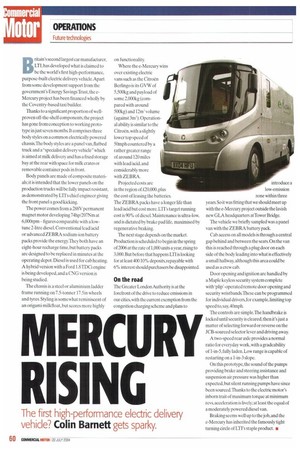IVIERC SIN
Page 62

If you've noticed an error in this article please click here to report it so we can fix it.
The first high-performance electric delivery
vehicle? Collin Bameft gets sparky. Britain's second largest car manufacturer, LTI,has developed what is claimed to be the world's first high-performance, purpose-built electric delivery vehicle.Apart from some development support from the government's Energy Savings Trust, the eMercury project has been financed wholly by the Coventry-based taxi builder.
Thanks to a significant proportion of wellproven off-the-shelf components, the project has gone from conception to working prototype in just seven months. It comprises three body styles on a common electrically powered chassis.The body styles are a panel van, flatbed truck and a "specialist delivery vehicle" which is aimed at milk delivery and has a fixed storage bay at the rear with space for milk crates or removable container pods in front.
Body panels are made of composite materials; it is intended that the lower panels on the production trucks will be fully impact resistant, as demonstrated by LTI's chief engineer giving the front panel a good kicking.
The power comes from a 288V permanent magnet motor developing 74hp/207Nm at 6,000rprn— figures comparable with a lowtune 2-litre diesel. Conventional lead/acid or advanced ZEBRA sodium-ion battery packs provide the energy.They both have an eight-hour recharge time, but batterypacks are designed to be replaced in minutes at the operating depot. Diesel is used for cab heating. A hybrid version with a Ford 1.8 TDCI engine is being developed, and a CNG version is being studied.
The chassis is a steel or aluminium ladder frame running on 7.5tonner 17.5in wheels and tyres. Styling is somewhat reminiscent of an origami milkfloat, but scores more highly on functionality.
Where the e-Mercury wins over existing electric vans such as the Citroen Berlingo is its GVW of 5,500kg and payload of some 2,000kg (compared with around 500kg) and 12m3 volume (against 3m3). Operational ability is similar to the Citroen, with a slightly lower top speed of 50mph countered by a rather greater range of around 120 miles with lead/acid, and considerably more with ZEBRA.
Projected costs are in the region of £20.000,plus the cost of leasing the batteries. The ZEBRA packs have a longer life than lead/acid but cost more. LTI's target running cost is 90% of diesel. Maintenance is ultra-low, and is dictated by brake pad life, maximised by regenerative braking.
The next stage depends on the market. Production is scheduled to begin in the spring of 2006 at the rate of 1,000 units a year, rising to 3,000. But before that happens LTI is looking for at least 40010% deposits, repayable with 6% interest should purchasers be disappointed.
On the road
The Greater London Authority is at the forefront of the drive to reduce emissions in our cities, with the current exemption from the congestion charging scheme and plans to introduce a low-emission zone within three years. So it was fitting that we should meet up with the e-Mercury project outside the lavish new GLA headquarters atTower Bridge, The vehicle we briefly sampled was a panel van with the ZEBRA battery pack.
Cab access on all models is through a central gap behind and between the seats. On the van this is reached through a plug door on each side of the body leading into what is effectively a small hallway, although this area could be used as a crew cab.
Door opening and ignition are handled by a Maple keyless security system complete with `plip'-operated remote door opening and security wristbands.These can be programmed for individual drivers, for example, limiting top speed to, say,40mph.
The controls are simple.The handbrake is locked until security is cleared, then it's just a matter of selecting forward or reverse on the JCB-sourced selector lever and driving away.
A two-speed rear axle provides a normal ratio for everyday work, with a gradeability of 1-in-5. fully laden. Low range is capable of restarting on a 1-in-3 slope.
On this prototype, the sound of the pumps providing brake and steering assistance and suspension air pressure was higher than expected, but silent running pumps have since been soureed.Thanks to the electric motor's inborn trait of maximum torque at minimum revs, acceleration is lively; at least the equal of a moderately powered diesel van.
Braking seems well up to the job, and the e-Mercury has inherited the famously tight turning circle of LTI's staple product. •






























































































































































































